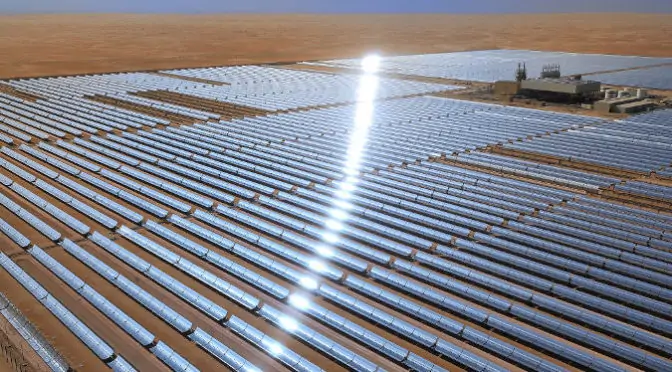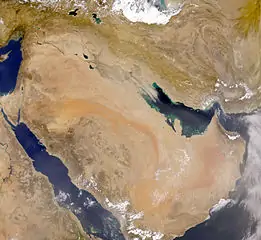The summer of 2016 has been a major pivot in the history of mankind. In effect, on 30 August, the definition of the current geological epoch as the “Anthropocene Era” has been officially validated, during the 35th International Geological Congress, in Cape Town, South Africa (Noel Castree, “An Official Welcome to the Anthropocene Epoch”, RD Mag, O8/31/2016).
Our new geological period is thus defined as being “anthropos” (meaning “human”) driven, because humankind has become the major geological and biological force on Earth. This happened  through the combination of use of carbon energy, industry, agriculture, urbanisation, modern transportation, and nuclear development, which are all profoundly altering the geophysical and biological conditions of the Earth system (Waters, Zalasiewicz et al., “The Anthropocene is functionally and stratigraphically distinct from the Holocene”, Science, 08 January 2016).
through the combination of use of carbon energy, industry, agriculture, urbanisation, modern transportation, and nuclear development, which are all profoundly altering the geophysical and biological conditions of the Earth system (Waters, Zalasiewicz et al., “The Anthropocene is functionally and stratigraphically distinct from the Holocene”, Science, 08 January 2016).
The massive strategic problem linked to this new epoch is that the planetary present and future are now dominated by complex dynamics of global change. The rhythm of planetary evolution is now attuned to the chaotic coupling of the Earth system’s cycles with the current human technological, industrial and urban forms of development (Jean-Michel Valantin, “The Planetary Crisis Rules, Part. 1 and 2”, The Red (Team) Analysis Society, January 25, 2016 and February 15, 2016).
The current forms of economic development are now undergoing a fundamental risk of disruption.
We need to understand that our modern societies are far from being adapted to this new planetary reality, into which the atmosphere, climate, water, soils, and biology cycles are altered (James Howard Kunstler, The Long emergency, 2005). For example, the current anthropogenic climate change is an important signal of the Anthropocene.
It derives of this new ![July 5, 2011 A Super Sand Storm, reported by some Phoenix media channels as "The largest Sand Storm in the history of Arizona” by Roxy Lopez (Own work) [CC BY-SA 3.0 (http://creativecommons.org/licenses/by-sa/3.0) or GFDL (http://www.gnu.org/copyleft/fdl.html)], via Wikimedia Commons](https://redanalysis.org/wp-content/uploads/2016/09/Duststorm.jpg) geophysical reality that, in our period of globalised economy, the Anthropocene turning point bears a profound meaning: the current forms of economic development are now undergoing a fundamental risk of disruption.
geophysical reality that, in our period of globalised economy, the Anthropocene turning point bears a profound meaning: the current forms of economic development are now undergoing a fundamental risk of disruption.
In the first article of this series, we shall initially see, through some climate-related extreme events, how the economy is threatened. Then, we shall deepen our emerging understanding by further pointing out the economic disruption brought about by the climate dimension of the Anthropocene. Finally, we shall review the emerging need for economic adaptation to this new situation.
Climate change versus economy
The Anthropocene is rapidly becoming the new planetary reality. And this new reality is very dangerous for the current state of the world economy, because the latter has been developed within a given set of planetary conditions, which are quickly and deeply transformed (Thomas Homer Dixon, The Upside of down, catastrophe, creativity and the renewal of civilization, 2006).
This danger is expressed, among others, through the growing pressure exercised by the numerous impacts of climate change on the economic context. For example, the period between May and September 2016 has been a climate nightmare for the American and Canadian economies.
In May 2016, a mega wildfire spread throughout Alberta and devastated the region of Fort ![andscape_view_of_wildfire_near_highway_63_in_south_fort_mcmurray Par DarrenRD (Travail personnel) [CC BY-SA 4.0 (http://creativecommons.org/licenses/by-sa/4.0)], via Wikimedia Commons landscape_view_of_wildfire_near_highway_63_in_south_fort_mcmurray](https://redanalysis.org/wp-content/uploads/2016/09/Landscape_view_of_wildfire_near_Highway_63_in_south_Fort_McMurray-300x169.jpg) McMurray (Bryan Alary, “Fort Mc Murray blaze among “most extreme” of wild fires says researcher”, Phys.org, May 9, 2016). This humongous fire took place directly in the heartland of the world-famous tar sands’ exploitations, which turned Canada into an oil product exporter (Andrew Nikiforuk, Tar sands: dirty oil and the future of a continent, 2010).
McMurray (Bryan Alary, “Fort Mc Murray blaze among “most extreme” of wild fires says researcher”, Phys.org, May 9, 2016). This humongous fire took place directly in the heartland of the world-famous tar sands’ exploitations, which turned Canada into an oil product exporter (Andrew Nikiforuk, Tar sands: dirty oil and the future of a continent, 2010).
In July, the Insurance Bureau of Canada released a survey establishing that this disaster would cost almost 3,6 bn dollars to the insurance sector, and was the second worst natural disaster in Alberta since the catastrophic floods that happened … in 2013, in a region that was not defined as a flood-prone area.
To these costs must be added those of the interruptions of operations on the tar sands’ exploitation sites, and of the public stores following the intervention of fire-fighters, also resulting from the evacuation of Fort McMurray’s population (Jean-Michel Valantin, “Alberta Mega WildFires and the United Arab Emirates Security”, The Red (Team) Analysis Security, May 23, 2016).
It was only the beginning.
In August, a flood of biblical proportions, stemming from tremendously heavy rains, engulfed ![louisiana_national_guard_convoy_in_flooded_denham_springs_15_august_2016 Par The National Guard [CC BY 2.0 (http://creativecommons.org/licenses/by/2.0)], via Wikimedia Commons louisiana_national_guard_convoy_in_flooded_denham_springs_15_august_2016](https://redanalysis.org/wp-content/uploads/2016/09/Louisiana_National_Guard_Convoy_in_Flooded_Denham_Springs_15_August_2016-300x200.jpg) more than twenty parishes in Louisiana, impacting more than 60 000 homes, 80% being non-insured against risks of flood, and 6 000 businesses. The related costs could reach more than 2.2 billion dollars, and add to the 1.3 billion loss generated by another giant flood, which happened in March 2016 (Holly Yan, “Louisiana’s mammoth floods: by the numbers”, CNN, August 22, 2016).
more than twenty parishes in Louisiana, impacting more than 60 000 homes, 80% being non-insured against risks of flood, and 6 000 businesses. The related costs could reach more than 2.2 billion dollars, and add to the 1.3 billion loss generated by another giant flood, which happened in March 2016 (Holly Yan, “Louisiana’s mammoth floods: by the numbers”, CNN, August 22, 2016).
Worse still, the total losses for the U.S. economy related to the August flood could reach between 10 to 15 billion dollars, considering direct damages, losses in property value and in tax revenues from businesses, as well as direct and indirect damages to agricultural activities (“USA-Louisiana Floods to Cost US Economy 10 to 15 Billion Dollars Says AON Benfield”, Flood List News in Insurance USA, 9 September 2016). Meanwhile, human impacts, such as loss of job, combination of health and financial insecurity and exhaustion should also be taken into account.
It is interesting to note that the Louisiana floods increasingly appear to be related to climate change. Given the fact that climate change keeps on intensifying, this raises important questions in terms of anticipation, warning and adaptation. (“Climate change increased chances of record rains in Louisiana by at least 40%”, National Oceanic and Atmospheric Agency, September 16, 2016).
In the meantime, on the West Coast, California burned. More than 27 wildfires occurred between May and the end of August, some of them being awfully powerful.
“It was raining fire from the sky” were the very words used by an evacuee to describe the infamous Sand Fire, or the terrible “Blue Cut fire” (Madison Park, “California wildfire evacuees: It was raining fire from the sky”, CNN, July 27 2016 and Steve Visser, “California Blue Cut fire contained, others threatening”, CNN, 22 August 2016).
![los_angeles_2009_fires Par Mathieu Marquer [CC BY-SA 2.0 (http://creativecommons.org/licenses/by-sa/2.0)], via Wikimedia Commons 320px-los_angeles_2009_fires](https://redanalysis.org/wp-content/uploads/2016/09/320px-Los_Angeles_2009_fires-300x225.jpg) At a deeper level, the Californian conurbations are under a growing risk. In effect, huge swaths of Californian urban sprawls have been built on natural fire corridors. The probability that these densely urbanised areas may interact with wild fires due to climate change is now growing (Mike Davis, Ecology of Fear, 1998).
At a deeper level, the Californian conurbations are under a growing risk. In effect, huge swaths of Californian urban sprawls have been built on natural fire corridors. The probability that these densely urbanised areas may interact with wild fires due to climate change is now growing (Mike Davis, Ecology of Fear, 1998).
The chronic state of drought that affects California, and the combination of a powerful El Nino combined with climate change powered those wildfires (Justin Worland “Don’t call California wild fires “natural disasters”, Time Magazine, August 17, 2016). The costs of the wildfires result from soaring budgets to fight wildfires, destruction of property, interruption of businesses, disruption of transportation system, ![blue_cut_fire_4_2016 Par San Bernardino County Sheriff's Department [Public domain], via Wikimedia Commons blue_cut_fire_4_2016](https://redanalysis.org/wp-content/uploads/2016/09/Blue_cut_fire_4_2016-300x200.jpg) and related insurance and rehabilitation costs (Western Forestry Leadership Coalition, The True Costs of Wildfire in the Western U.S, 2010).
and related insurance and rehabilitation costs (Western Forestry Leadership Coalition, The True Costs of Wildfire in the Western U.S, 2010).
In the Californian case, those costs must be added to those associated with the already long series of costs due to growing damages wrought by wildfires, especially since 2000 (“Chart: 13 of California’s 20 largest wildfires burned since 2000”, Climate Signals).
This new climate versus economy insecurity also takes other forms. For example, the long drought of the summer 2012 impacted more than 80% of American agricultural land. If the effects were less severe than expected, they were nonetheless felt on livestock food prices during the last quarter of 2012 and through slight but widely distributed rises in prices for different kinds of agricultural products (cereals, dairy, poultry, fruits) on the U.S. and international markets (USDA: U.S Drought 2012, Farm and Food Impacts, July 26, 2013.
Climate change and economic disruption
In a very strange and disturbing way, the Anthropocene epoch would thus emerge as a new kind of economic disruptive force. Its impacts are quite analogous to a kind of permanent geoeconomic offensive, because the Anthropocene creates a state of permanent risk of loss, for private persons, owners, business, and finance actors, the insurance industry, among others (Eric Reguly, “No climate-change deniers to be found in the reinsurance business“, The Globe and Mail, November 28, 2013).
A kind of rising permanent geoeconomic offensive, … a state of permanent risk of loss …
According to Ceres in 2014, the annual cumulated costs of all natural disasters in the United States during the 1980s reached approximately 3 billion dollars a year. During the first decade of the twenty-first century, this yearly total amounted to 20 billion dollars a year (with spikes, for example in 2005, due to the devastation of New Orleans by hurricane Katrina).
In 2011 and 2012, these costs borne by businesses, real estate owners, large and small, territories, industries, and agricultural actors, exploded, due to the very intense and early tornado season, and the devastation it brought to the Midwest. ![katrina-noaagoes12 By NOAA [Public domain], via Wikimedia Commons 320px-katrina-noaagoes12](https://redanalysis.org/wp-content/uploads/2016/09/320px-Katrina-noaaGOES12-300x188.jpg) The situation appeared dire enough to lead Frank Nutter, the President of the Reassurance Association of America (RAA), to testify in front of the U.S. Senate Committee on Environment and Public works on 18 July 2013 (Franklyn Nutter, Climate change: it’s happening now, July 18, 2013).
The situation appeared dire enough to lead Frank Nutter, the President of the Reassurance Association of America (RAA), to testify in front of the U.S. Senate Committee on Environment and Public works on 18 July 2013 (Franklyn Nutter, Climate change: it’s happening now, July 18, 2013).
This testimony was an opportunity to explain how the number of extreme weather and climate related events, such as tornadoes, hurricanes, floods, wildfires, and storms, is growing rapidly, while hammering densely populated spaces, like coastal shoreline regions, where more than 123 million people live (i.e. 39% of the U.S. population). What Frank Nutter makes very clear is the way people, home, communities, and infrastructures are increasingly exposed to the multiplication of weather-related shocks, while the federal means of action are at risk to be wanting in the face of this socio-climatic trends.
As another example, in 2012, hurricane Sandy inflicted more than 50 billion dollars damages to homes and infrastructures in New York City and New Jersey, while 116 people were killed (Chris Isidore, “Sandy’s cost to economy: up to 50 Billion dollars”, CNN Money, November 2, 2012).
![amr_ambulances_during_hurricane_sandy Par Suzyderkins (Travail personnel) [CC BY-SA 4.0 (http://creativecommons.org/licenses/by-sa/4.0)], via Wikimedia Commons amr_ambulances_during_hurricane_sandy](https://redanalysis.org/wp-content/uploads/2016/09/AMR_Ambulances_during_Hurricane_Sandy.jpg) This new situation is immersing the different actors of the economy in a permanently dangerous situation (Lord Nicholas Stern chair, The Economics of Climate Change, 2006 and Better Growth, better climate, The New Climate Economy Report, 2014).
This new situation is immersing the different actors of the economy in a permanently dangerous situation (Lord Nicholas Stern chair, The Economics of Climate Change, 2006 and Better Growth, better climate, The New Climate Economy Report, 2014).
And we are most likely to experiment much worse, as it must also be remembered that, due to global warming, sea levels are rising faster than thought a few years ago (The Independent, Sea levels rising more quickly than predicted, war scientists, 28 November 2012; Jean-Michel Valantin, “The Antarctic versus Dubai – The Planetary Crisis Rules, part 5”, The Red (Team) Analysis Society, May 2, 2016).
Furthermore, climate change impacts U.S. economic activity, through semi-continental weather events, which can also slow or disrupt the way people work or go to work, as has been seen during the different “polar vortex” episodes during the 2013-2014, 2015 and 2016 winters (Atmospheric and Environmental Research, “Arctic Oscillation Analysis and Forecasts”).
In other words, the very fabric of society and economy are put at risk by the actualisation of the new environmental conditions.
The Anthropocene disruption and the necessary adaptation
We have entered a period defined by the installation in the daily social and economic life of series of disruptive extreme environmental events. Their number is quickly growing in kind, number and intensity, especially over the last twenty years. This generates a state of profound and permanent disruption.
As often showed by The Red (Team) Analysis Society (see portal to Environment and Security), and as recalled above, this constant disruption is profoundly dangerous for the economy, through the multiplication of different forms of destructions and unexpected costs that must be absorbed by the economic system.
Moreover, contrary to the “creative destruction” theorised by Joseph Schumpeter as being an important engine of the modern economy, the Anthropocene “environmentally-man-made” and constant disruption is signaled by the spread of what we could call “destructive destruction”.
 This “destructive destruction” is at work in the combination of continually cumulating costs of direct and indirect damages over the last years, as we saw with the Alberta, Louisiana and California 2016 extreme events, caused by the violent, repetitive and intensifying nature of these events, that interact with the multiple vulnerabilities of modern societies and economies (Thomas Homer-Dixon, The Upside of Down, 2007).
This “destructive destruction” is at work in the combination of continually cumulating costs of direct and indirect damages over the last years, as we saw with the Alberta, Louisiana and California 2016 extreme events, caused by the violent, repetitive and intensifying nature of these events, that interact with the multiple vulnerabilities of modern societies and economies (Thomas Homer-Dixon, The Upside of Down, 2007).
These series of destructive extreme large-scale events are also symptoms of the rapid global disruption accompanying the emergence of the Anthropocene. From an economic point of view, this implies a necessary rapid and profound adaptation, in order to survive the coming “multi-storm”.
In order to find the principles of economic adaptation to an ever-changing state of disruption, the Red (Team) Analysis Society will focus, with the next article of this series on ways to combine the globalised economy with the principles of war economy and its built-in resilience.
About the author: Jean-Michel Valantin (PhD Paris) is the Director of Environment and Security Analysis at The Red (Team) Analysis Society. He is specialised in strategic studies and defence sociology with a focus on environmental geostrategy.






![British_carriers_during_Suez_Crisis_1956 Par Royal Navy official photographer [Public domain], via Wikimedia Commons 313px-British_carriers_during_Suez_Crisis_1956](https://redanalysis.org/wp-content/uploads/2016/07/313px-British_carriers_during_Suez_Crisis_1956-300x230.jpg)
![Operation_Desert_Storm_22 Par Tech. Sgt. David McLeod (Defenseimagery.mil, VIRIN DF-ST-92-09166) [Public domain], via Wikimedia Commons 320px-Operation_Desert_Storm_22](https://redanalysis.org/wp-content/uploads/2016/07/320px-Operation_Desert_Storm_22-300x201.jpg)

![Yukiya_Amano_at_Barakah_NPP_construction_site_(01890202)_(8426139733) Par IAEA Imagebank [CC BY-SA 2.0 (http://creativecommons.org/licenses/by-sa/2.0)], via Wikimedia Commons Yukiya_Amano_at_Barakah_NPP_construction_site_(01890202)_(8426139733)](https://redanalysis.org/wp-content/uploads/2016/07/Yukiya_Amano_at_Barakah_NPP_construction_site_01890202_8426139733-300x200.jpg)
![Artist_Concept_-_Astronaut_Performs_Tethering_Maneuvers_at_Asteroid By NASA [Public domain], via Wikimedia Commons 320px-Artist_Concept_-_Astronaut_Performs_Tethering_Maneuvers_at_Asteroid](https://redanalysis.org/wp-content/uploads/2016/07/320px-Artist_Concept_-_Astronaut_Performs_Tethering_Maneuvers_at_Asteroid-300x225.jpg)




![Sheikh_Mohammed_bin_Zayed_Al_Nahyan_on_13_May_2008_Pict_1 Par Imre Solt [GFDL (http://www.gnu.org/copyleft/fdl.html) ou CC-BY-SA-3.0 (http://creativecommons.org/licenses/by-sa/3.0/)], via Wikimedia Commons 320px-Sheikh_Mohammed_bin_Zayed_Al_Nahyan_on_13_May_2008_Pict_1](https://redanalysis.org/wp-content/uploads/2016/06/320px-Sheikh_Mohammed_bin_Zayed_Al_Nahyan_on_13_May_2008_Pict_1-300x174.jpg) Sheikh al-Nahyan is, in the same time, the principal adviser to the President of the U.A.E. on energy issues, Deputy Supreme Commander of the Armed Forces and a member of the board of Abu Dhabi’s powerful sovereign fund (“
Sheikh al-Nahyan is, in the same time, the principal adviser to the President of the U.A.E. on energy issues, Deputy Supreme Commander of the Armed Forces and a member of the board of Abu Dhabi’s powerful sovereign fund (“![Oil Rig at Port Khaled (Sharjah,_UAE) Par Basil D Soufi (Travail personnel) [CC BY-SA 3.0 (http://creativecommons.org/licenses/by-sa/3.0)], via Wikimedia Commons 320px-Oil_Rig_at_Port_Khaled_(Sharjah,_UAE)](https://redanalysis.org/wp-content/uploads/2016/06/320px-Oil_Rig_at_Port_Khaled_Sharjah_UAE-300x225.jpg)
![Masdar_city_under_construction_2012 Par Jan Seifert [CC BY 2.0 (http://creativecommons.org/licenses/by/2.0)], via Wikimedia Commons 320px-Masdar_city_under_construction_2012](https://redanalysis.org/wp-content/uploads/2016/06/320px-Masdar_city_under_construction_2012-300x225.jpg)
![Gemasolar2012 By Ion Tichy (Own work) [CC BY-SA 3.0 (http://creativecommons.org/licenses/by-sa/3.0)], via Wikimedia Commons 320px-Gemasolar2012](https://redanalysis.org/wp-content/uploads/2016/06/320px-Gemasolar2012-300x200.jpg) The Emirate is also a major partner in the Gemasolar 20 megawatts plant in Spain, and has a 20% share in the London Array wind power project, which aims to generate 630 megawatt power, an energy level sufficient to power 500.000 British homes (Keyrouz, ibid). By doing this, the U.A.E. is recreating its capacity to export energy in a very innovative way.
The Emirate is also a major partner in the Gemasolar 20 megawatts plant in Spain, and has a 20% share in the London Array wind power project, which aims to generate 630 megawatt power, an energy level sufficient to power 500.000 British homes (Keyrouz, ibid). By doing this, the U.A.E. is recreating its capacity to export energy in a very innovative way.![CSIRO_ScienceImage_2143_Solar_tower_at_CSIRO_Energy_Centre_creating_solar_steam CSIRO [CC BY 3.0 (http://creativecommons.org/licenses/by/3.0)], via Wikimedia Commons CSIRO_ScienceImage_2143_Solar_tower_at_CSIRO_Energy_Centre_creating_solar_steam](https://redanalysis.org/wp-content/uploads/2016/06/CSIRO_ScienceImage_2143_Solar_tower_at_CSIRO_Energy_Centre_creating_solar_steam-300x225.jpg)
![Dunhuang.champs.de.panneaux.solaires By Popolon (Own work) [CC BY-SA 3.0 (http://creativecommons.org/licenses/by-sa/3.0)], via Wikimedia Commons 320px-Dunhuang.champs.de.panneaux.solaires](https://redanalysis.org/wp-content/uploads/2016/06/320px-Dunhuang.champs.de_.panneaux.solaires-1-300x199.jpg) The U.A.E. is devising a grand strategy based on the political, industrial, financial, scientific and technological promotion of renewable energy, in order to keep its affluence and influence in an age of oil decline and climate change. The U.A.E. is getting ready to become a strategic, industrial, and financial hegemon of the rising sustainability industry.
The U.A.E. is devising a grand strategy based on the political, industrial, financial, scientific and technological promotion of renewable energy, in order to keep its affluence and influence in an age of oil decline and climate change. The U.A.E. is getting ready to become a strategic, industrial, and financial hegemon of the rising sustainability industry.

